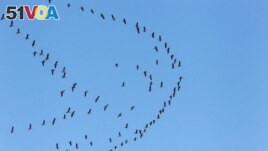A new United Nations report says one-fifth of the world's migrating animals are at risk of disappearing.
Animals that migrate move from one area to another at different times of the year.
The report, called State of the World's Migratory Species, was released February 12. It blames population drops on environmental changes linked to human activities.

FILE - Migratory birds fly through the sky of southern Lebanon March 28, 2021. (REUTERS/Aziz Taher)
The threats the animals face include habitat loss, illegal hunting and fishing, pollution and climate change.
Many kinds of migratory animals – including songbirds, sea turtles, whales, sharks and others – move to different environments as the seasons change.
The U.N. report says about 44 percent of migratory species around the world are decreasing in population. In addition, about one in five of 1,200 species watched by the U.N. are at risk of becoming extinct, or completely disappearing.
Kelly Malsch was the lead writer of the report. She told The Associated Press, "These are species that move around the globe. They move to feed and breed and also need stopover sites along the way."
Malsch said any habitat loss or other threats during their trip can make animal populations fall. "Migration is essential for some species. If you cut the migration, you're going to kill the species," said Stuart Pimm. He is an ecologist at Duke University in North Carolina who was not part of the report.
The researchers examined existing data, including information from the International Union for Conservation of Nature's Red List. The list identifies wildlife across the world currently facing threats.
The report was presented at a meeting of the U.N.'s Convention on the Conservation of Migratory Species of Wild Animals in Samarkand, Uzbekistan. Attendees of the gathering are examining proposals for conservation measures. They are also working to identify new species of concern.
Susan Lieberman is vice president for international policy at the nonprofit Wildlife Conservation Society. She told the AP, "One country alone cannot save any of these species."
Lieberman noted that eight South American governments at the meeting are expected to propose the addition of two threatened catfish to the U.N.'s list of species of concern. The catfish live in the Amazon River basin, the world's largest freshwater system. If the habitat there can be saved, the catfish will do well, Lieberman said. "It's about protecting the habitat," she added.
The report found habitat loss affected up to 75 percent of the species studied. The report said this shows a big need for more connectivity between separated ecosystems. It urges governments to take steps to avoid harming habitats and migration paths when building dams, pipelines or wind power equipment.
"We need to look at the top levels of government decision-making," said Amy Fraenkel. She is executive secretary of the U.N. Convention on the Conservation of Migratory Species. Fraenkel told Reuters news agency the goal is to consider the best ways animals and humans can have their needs met. "We all need to survive," Fraenkel added.
She noted the problems migratory animals face are also linked to temperature changes across the planet.
These changes, Fraenkel added, hurt the timing of migrations, cause heat stress and drive increasingly destructive weather-related events.
She said, "The changes that had been already predicted some years ago are now happening."
I'm Bryan Lynn.
The Associated Press and Reuters reported on this story. Bryan Lynn adapted the reports for VOA Learning English.
__________________________________________
Words in This Story
migrate – v. travel from one place to another at the same time each year
globe – n. the world
habitat – n. the natural environment of a plant or animal
species – n. a group of animals or plants that are similar and can produce young animals or plants
breed – v. to produce young animals
essential – adj. completely necessary
ecologist – n. a person who studies the relationship between living things and the environment
conservation – n. an organized effort that aims to protect animals and natural resources
ecosystem – n. all the living things in a particular area, as well as the ways the things affect each other and the environment
